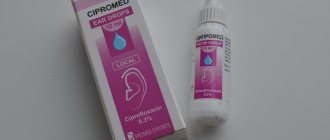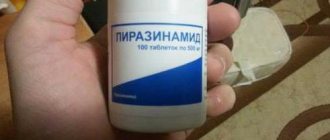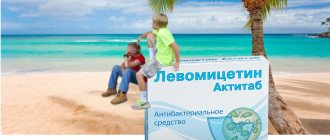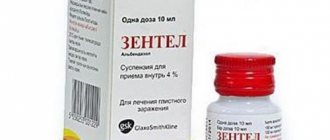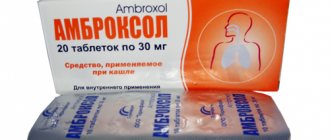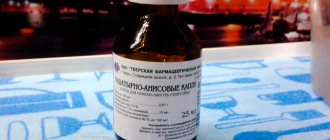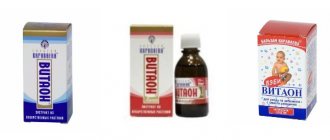Pharmacodynamics and pharmacokinetics
Griseofulvin is synthesized in the cells of the fungi Penicillium nigricans. Griseofulvin is an antifungal drug that is actively used in the treatment of lesions of the skin, hair and nails of fungal etiology. It has a pronounced fungistatic effect on fungi of the genus Dermatomycetes (causative agents of fungal skin diseases), on representatives of the genus Trichophyton (causative agents of trichophytons - diseases of the scalp and nail diseases), on the causative agent of microsporia , on fungi of the genus Epidermophytons (causative agents of epidermophytons - inflammatory diseases of the skin in the groin and feet, as well as nail diseases).
The fungistatic effect of Griseofulvin is caused by the fact that the drug inhibits the processes of fungal cell division in metaphase and disrupts the structure of the fungus.
Ineffective against yeast-like fungi of the genus Candida; it is not prescribed for candidiasis .
Griseofulvin is well absorbed through the intestinal wall, and in the human body it exhibits a pronounced affinity for the stratum corneum lipophilic layer of the skin, hair and tissues of the nail bed.
Thanks to these properties, a high concentration of the drug is achieved precisely in the lesions.
Metabolism of Griseofulvin occurs in the liver, and the drug is excreted from the body through the intestines and kidneys. The half-life of Griseofulvin is 24 hours.
Contraindications
Griseofulvin is contraindicated in cases of severe damage to the kidneys and liver, and in case of porphyria (a group of diseases associated with impaired pigment metabolism).
Griseofulvin cannot be prescribed if the patient has malignant neoplasms, severe leukopenia , changes in the cellular composition of the blood and systemic diseases of the hematopoietic organs.
If you have diabetes mellitus, you should avoid using Griseofulvin suspension, since the latter contains glucose.
Griseofulvin is not prescribed during pregnancy and breastfeeding.
Prescription of the drug should be avoided if the patient has systemic connective tissue diseases and a history of acute cerebrovascular accident
Side effects
Griseofulvin can cause disruption of the digestive system, in particular, patients may begin to complain of pain in the epigastric region, the appearance of dyspeptic disorders in the form of nausea and even vomiting. , stool upset (or constipation or diarrhea may occur .
From the central nervous system, headaches, dizziness, neurological and asthenovegetative symptoms may occur.
photosensitivity (increased sensitivity to visible light and ultraviolet rays) may develop Griseofulvin can cause disorders of the hematopoietic system, which will manifest as leukopenia or other similar changes in the morphological picture of the blood. If such side effects occur, you should choose a wait-and-see approach and stop taking the drug for three to four days.
Allergic rashes may occur on the skin, including polymorphic erythema and skin necrolysis .
Adverse reactions
Undesirable side effects occur infrequently, but it is worth knowing about them so that when the first signs appear, consult a doctor and possibly stop using the drug.
Such reactions include:
- symptoms of dyspepsia (nausea, vomiting, diarrhea, abdominal pain);
- allergic manifestations (urticaria, skin rash, toxic epidermal necrolysis);
- changes in blood composition (granulocytopenia, leukopenia);
- dizziness, headache;
- increased sensitivity to sunlight;
- candidal stomatitis.
Instructions for use of Griseofulvin (Method and dosage)
Tablet dosage regimen
Tablets should be taken orally with 1 tsp. vegetable oil during meals.
For microsporia, adults are prescribed 8 tablets per day, children - 21-22 milligrams per kilogram of body per day. The duration of therapy is determined as follows: Griseofulvin is taken every day until the first negative test results for fungi, then the dosage is maintained for another two weeks, but the drug is taken every other day, and after another two weeks the frequency of administration is reduced to twice a week.
For favus and infiltrative-suppurative trichophytosis, adults are prescribed Griseofulvin in the same dosage and according to the same regimen; for the treatment of children, it is necessary to adjust the dose - 18 milligrams per kilogram of body per day, but the regimen does not change.
During the treatment of mycoses of the head, it is necessary to shave the hair once a week and wash the hair with soap a couple of times a week.
The dosage will depend on body weight: for example, for a weight up to 50 kg, five tablets (625 milligrams) are enough. For body weight above the given figure, one tablet of Griseofulvin should be added for every 10 kilograms, but not more than a gram per day. The daily dose for children and adolescents is calculated using the formula 16 milligrams per kilogram of body weight.
Therapy for onychomycosis is carried out according to the following scheme: Griseofulvin is taken every day for a month, and from the second month - once every two days, and then switched to twice a week. The duration of therapy is eight months or more (treatment may take a year). In the case of severe and treatment-resistant nail damage, the prescription of the drug must be combined with local therapy (both the same drug and other antimycotic agents), and in extremely difficult cases, it is possible to remove the nail plate with keratolytic agents.
Liniment (ointment) Griseofulvin, instructions for use
Liniment is used for localized skin lesions on its own, plus in combination with taking Griseofulvin orally for more extensive lesions.
The ointment is applied in a thin layer 1-2 times a day for an average of 2-3 weeks.
GRISEOFULVIN
GRISEOFULVIN
(
Griseofulvinum
; synonym:
grisovin, fulcin, sporostatin
, etc.;
sp. B
) is an antifungal antibiotic formed during the biosynthesis of Penicillium griseofulvum and other types of fungi (according to the botanical class). Total formula C17H17O6Cl, mol. weight 352.77. G. is active against all types of trichophytons, many types of microsporons, achorions, and also epidermophytons. Yeast-like fungi of the genus Candida, actinomycetes, as well as most pathogenic fungi that cause generalized deep mycoses are resistant to G. G. acts only fungistatically. Cross-resistance of pathogens to G. and other antibiotics was not detected. There is no increase in resistance during G.'s treatment. G.'s activity decreases in the presence of blood serum (binding by 80%). The mechanism of G.'s antifungal action is probably associated with disruption of the synthesis of the cell wall of dermatophytes, the formation of complexes with soluble RNA, and suppression of protein synthesis.
When taken orally, G. is well absorbed, reaching maximum concentration after 4-5 hours. after introduction. An increase in the optimal daily dose of G. does not increase its level in the blood. Highly dispersed G. powder with a particle size of no more than 4 microns is absorbed approximately 2 times better than ordinary fine-crystalline powder. G. selectively accumulates in the stratum corneum of the epidermis, the matrix of nails, and the root zone of hair, protecting newly formed keratin from damage by fungi. In the lower parts of the stratum corneum, G. is detected after 3 days of treatment, in the middle parts - after 10-15 days, in the upper parts - only by the 30-50th day, which indicates the need for long-term therapy. G. is excreted in feces and urine (about 1% in biologically active form and up to 75% in the form of inactive metabolites).
Indication
The following diseases are suitable for G.'s use: favus of the scalp and smooth skin, trichophytosis of the scalp and smooth skin (including chronic), microsporia of the scalp and smooth skin, epidermophytosis of smooth skin caused by red epidermophyton (Trichophyton) , onychomycosis caused by achorion, trichophyton and red epidermophyton, trichophytosis and favus lymph, nodes and bones.
G. is not effective for actinomycosis, blastomycosis, candidiasis, chromoblastomycosis, coccidioidomycosis, histoplasmosis and other generalized mycoses, as well as for pityriasis and erythrasma. G. is prescribed only for a typical wedge, a picture of mycoses, confirmed by repeated laboratory tests.
G. is used only internally, mainly in a highly dispersed form - for adults and children over 15 years of age, usually in a single dose of 125 mg (1 tablet) 4 times a day; children under 3 years old - 0.5 tablets 2-3 times a day; from 3 to 7 years, 1 tablet 2 times a day; from 7 to 15 years, 1 tablet 3 times a day. The duration of therapy is determined by the period of complete regeneration of the affected area: for mycoses of the scalp - 1-3 months, onychomycosis - 3-8 months. During the first 3 weeks. G. is taken daily, then every 1 or 2 days. When treating G. mycoses of the scalp, X-ray epilation is not required; for onychomycosis, it is advisable to remove the nail plates surgically or with keratolytic agents. Treatment is continued until four times negative results of microscopic examination are obtained, carried out at intervals of 2-5 days.
G.'s suspension is intended for ch. arr. for the treatment of children. It contains 15 mg of antibiotic in 1 ml. Children under 3 years old are prescribed 1 teaspoon 2-3 times a day before meals, from 3 to 7 years old - a dessert spoon 2 times a day, from 7 to 15 years old - the same dose 3 times a day.
In therapeutic doses, G. is well tolerated. However, some patients experience headache and dizziness. Increasing doses may cause insomnia and disorientation. Side effects often include decreased appetite, heaviness in the stomach, nausea, and diarrhea. Allergic reactions (maculopapular or urticarial rash, photosensitivity) may be associated with sensitization to G. or to the causative agent of the disease. As a rule, adverse reactions are mild and do not require discontinuation of treatment, but only a reduction in the dose of the drug. When treating G., it is recommended to prescribe ascorbic acid, thiamine, riboflavin, and nicotinic acid.
G. contraindicated
for systemic blood diseases, kidney and liver damage, malignant neoplasms, pregnancy. The drug should not be prescribed on an outpatient basis to transport drivers, pilots, or people working at heights. G.'s suspension should not be prescribed for diabetes.
G. released
in tablets of 0.125 g and suspensions in bottles of 100 and 200 ml. Store in a dry place at room temperature.
See also Antifungal antibiotics.
Bibliography:
Navashin G. M. and Fomina I. P. Handbook of antibiotics, p. 269, M., 1974.
S. M. Navashin.
special instructions
The drug affects the speed of decision-making and the speed of reaction, therefore the prescription of the drug requires a refusal to drive vehicles and a temporary cessation of activities that require extreme psychomotor reactions.
Therapy with Griseofulvin requires monitoring the morphological picture of the blood twice a month. If severe allergic reactions occur, you must first resort to antiallergic therapy, and then, if it is ineffective, stop taking Griseofulvin for 4-5 days. After this, you need to resume taking the drug, but increase the dose gradually and very carefully - start with half a tablet, and slowly increase to the therapeutic dose.
In pediatrics, it is recommended to combine this medicine with multivitamin complexes.
Griseofulvin price, where to buy
The price of Griseofulvin in 125 mg tablets is 250-300 rubles per pack of 20 pieces.
The price of the ointment is unknown. Liniment is not available in online pharmacies.
- Online pharmacies in RussiaRussia
- Online pharmacies in UkraineUkraine
ZdravCity
- Griseofulvin tablets 0.125g 20 pcs. PAO Biosintez
RUB 279 order
Pharmacy Dialogue
- Griseofulvin (tab. 125 mg No. 20) Biosynthesis JSC
RUB 249 order
show more
Pharmacy24
- Griseofulvin 0.125 g No. 40 tablets PAT NEC "Borshchagivsky chemical and pharmaceutical plant", Kiev, Ukraine
42 UAH. order
Release form and composition
The active component of Griseofulvin is the substance of the same name.
Dosage forms of the drug:
- Oral suspension (griseofulvin concentration – 100 mg/ml);
- Tablets 125 mg;
- Liniment 2.5%.
Griseofulvin tablets go on sale packaged in 10 pieces in blister packs, 2 blisters in each cardboard pack.
The suspension is sold in 100 ml glass jars with screw-on plastic caps.
Liniment is available in 30 gram quantities in orange glass jars.
